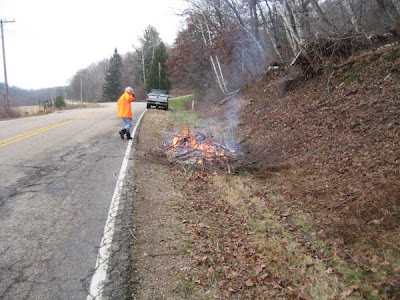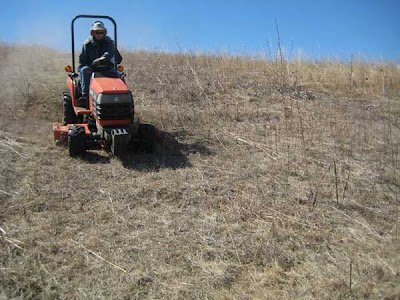
We had a nice light snow Friday night, making this an ideal time to burn a brush pile. We have been building one major pile since mid-summer and we generally burn it with the first snow.
We have been building and burning this same pile along Pleasant Valley Road for the past five years. During summer, it mainly gets weeds such as sweet clover, wild parsnip, and hedge parsley, armloads that are too big to get rid of any other way. Garlic mustard would also be included if we had any to get rid of. These are flowering plants which might produce viable seed if allowed to lie on the ground. Therefore, we carefully throw them on the pile so that the seeds cannot spread. Alternatively, we bag them and throw the bags on the pile.
In the fall, we have plenty of woody vegetation to throw on the same pile, and this provides good fuel for the burn.
We build this pile right next to the town road, since that makes it easy for us to get rid of all the "bad" stuff, throwing from the back of the truck or utility vehicle. By Christmastime this pile is fairly large, and has lots of flammable material.
Since this pile is right next to the Valley Prairie and just across the road from the Pocket Prairie, we need to wait for snow before we burn the pile, since both of these prairies have lots of flammable material. If we had a spot fire with each of them, a whole prairie might go up in flames.
We don't need much snow, just enough to cover the ground.
Yesterday, Amanda and Diane spent most of the day burning and tending this pile. (Kathie and I mainly kibitzed.)
There is a real technique to burning a brush pile. The important thing is to turn all the biomass into a small pile of ashes. The pile should be lighted from the bottom with drip torch fuel (3:1 ratio of diesel to gasoline). A Chapin stainless steel sprayer works well, since the fire can be brought into the center of the pile as well as horizontally. (Don't
ever use gasoline alone! Highly dangerous!)
The main work in burning a brush pile is consolidating the brush, logs, and other plant material into the center. The goal is to end up with a small area of ashes alone. There is always a lot of wood that has rolled away from the burning pile. A pitchfork works well here, since pieces of burning wood can be lifted up and tossed back in the center. If a pitchfork is not available, a long-handled shovel can be used.
Because of the snow, there is no danger that the fire will spread out of the burn zone, so once the pile has been well consolidated, one can leave it smoldering. However, it is a good idea to check the pile before leaving for the day.
One of the interesting phenomena with such a pile is that late next spring there may often be a zone of seedlings surrounding the area of the pile. These represent viable seeds that were just outside the hot zone and hence did not get killed by the fire. A glyphosate spray takes care of these seedlings.













